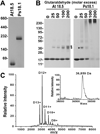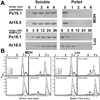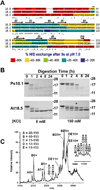An unusual dimeric small heat shock protein provides insight into the mechanism of this class of chaperones
- PMID: 23416558
- PMCID: PMC3646915
- DOI: 10.1016/j.jmb.2013.02.011
An unusual dimeric small heat shock protein provides insight into the mechanism of this class of chaperones
Abstract
Small heat shock proteins (sHSPs) are virtually ubiquitous stress proteins that are also found in many normal tissues and accumulate in diseases of protein folding. They generally act as ATP-independent chaperones to bind and stabilize denaturing proteins that can be later reactivated by ATP-dependent Hsp70/DnaK, but the mechanism of substrate capture by sHSPs remains poorly understood. A majority of sHSPs form large oligomers, a property that has been linked to their effective chaperone action. We describe AtHsp18.5 from Arabidopsis thaliana, demonstrating that it is dimeric and exhibits robust chaperone activity, which adds support to the model that suboligomeric sHSP forms are a substrate binding species. Notably, like oligomeric sHSPs, when bound to substrate, AtHsp18.5 assembles into large complexes, indicating that reformation of sHSP oligomeric contacts is not required for assembly of sHSP-substrate complexes. Monomers of AtHsp18.5 freely exchange between dimers but fail to coassemble in vitro with dodecameric plant cytosolic sHSPs, suggesting that AtHsp18.5 does not interact by coassembly with these other sHSPs in vivo. Data from controlled proteolysis and hydrogen-deuterium exchange coupled with mass spectrometry show that the N- and C-termini of AtHsp18.5 are highly accessible and lack stable secondary structure, most likely a requirement for substrate interaction. Chaperone activity of a series of AtHsp18.5 truncation mutants confirms that the N-terminal arm is required for substrate protection and that different substrates interact differently with the N-terminal arm. In total, these data imply that the core α-crystallin domain of the sHSPs is a platform for flexible arms that capture substrates to maintain their solubility.
Copyright © 2013 Elsevier Ltd. All rights reserved.
Figures







References
-
- van Montfort R, Slingsby C, Vierling E. Structure and function of the small heat shock protein/alpha-crystallin family of molecular chaperones. Adv Protein Chem. 2001;59:105–156. - PubMed
-
- Gusev NB. The Role of Intrinsically Disordered Regions in the Structure and Functioning of Small Heat Shock Proteins. Curr Protein Pept Sci. 2011 - PubMed
-
- Clark JI, Muchowski PJ. Small heat-shock proteins and their potential role in human disease. Curr Opin Struct Biol. 2000;10:52–59. - PubMed
Publication types
MeSH terms
Substances
Grants and funding
LinkOut - more resources
Full Text Sources
Other Literature Sources
Molecular Biology Databases

